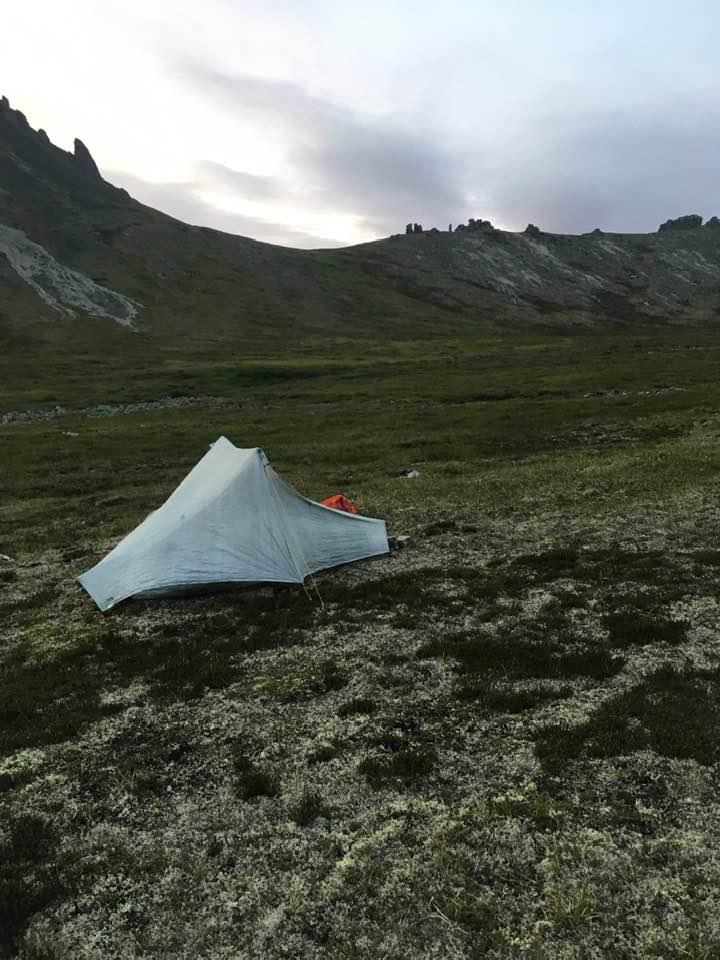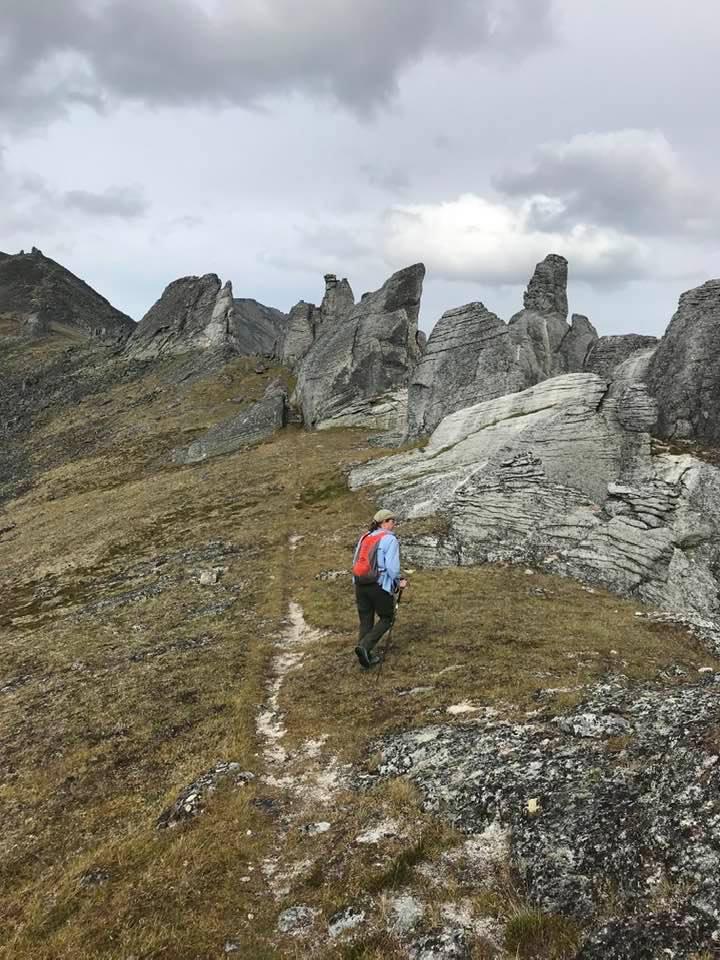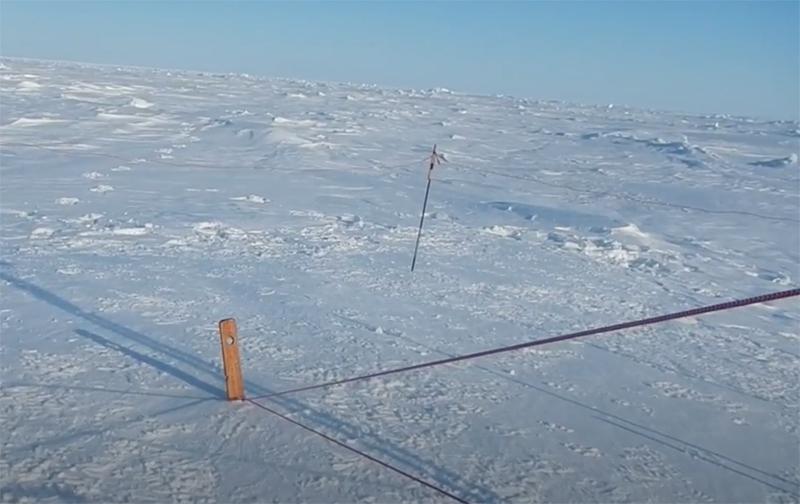Topic
Still struggling with my trekking pole tent – help?
Forum Posting
A Membership is required to post in the forums. Login or become a member to post in the member forums!
Home › Forums › General Forums › General Lightweight Backpacking Discussion › Still struggling with my trekking pole tent – help?
- This topic has 30 replies, 19 voices, and was last updated 3 years, 6 months ago by
 Eric Blumensaadt.
Eric Blumensaadt.
-
AuthorPosts
-
Aug 2, 2020 at 3:50 pm #3668180
This is the third trip out this summer with my Tarptent Notch Li. I still don’t have it right. Despite using longer stakes and rocks to hold them, I’m just not getting a very secure pitch. It’s also taking me three times longer to set it up than anyone around me with standard arched-pole tents. If I actually encountered rough weather – which I fortunately haven’t – I’d be using it as a bivy, collapsed around me or begging for a spot in another tent. Trying to tension one end pulls the other end out. The alpine tundra is soft two feet down, with lots of small rocks, but no real soil to hold the stakes.
Note in my photo here the effect of wind on the tent, pushing the sides directly against the inner. That would be a disaster in the rain; I’ve gotten really lucky! At 4:30am I did lower the poles a bit and retension, and that helped it stop flapping and it looked better, but I still didn’t feel very secure. I’m always in the alpine and the wind is always blowing; those are my camping conditions. Maybe this just isn’t a very good tent for me? to be fair, other tents I’ve been around this summer also had pegs pull out, or were flapping, but they didn’t completely collapse since the poles held them up even without being fully staked. Maybe modding it with some addition tie downs along the sides? I am a little sick of spending 1/2 hour gathering rocks every time I set it up, while others are fully camped and eating dinner. Especially after 15 miles of hard hiking and I just want to rest!
Despite all that, we had a glorious 2 day 1 night out, not far from home. We climbed a ridge of tors, up to a summit. I’ll post a few more photos. Up on that ridge in this photo you can see valleys and mountains forever. We slack packed up the ridge to the top, 5286 feet summit (not sure of the elevation at camp). Lots of Dall sheep, and we had the valley completely to ourselves for the night. The breeze kept the bugs away (they’ve been really really bad this year in Alaska). I got to sit in my tent door and sip my coffee, while watching sheep on the hillside, birds all around, just idyllic!

If I can’t figure this out, this puppy will be on gear swap soon! I stupidly marked it with my name (since I lend gear, I mark everything in order to get it returned to me) but otherwise it’s in perfect, near new condition.
Aug 2, 2020 at 3:58 pm #3668184 Aug 2, 2020 at 5:03 pm #3668198
Aug 2, 2020 at 5:03 pm #3668198For your conditions I think I’d look at the Double Rainbow Li.
Aug 2, 2020 at 7:15 pm #3668220Solomid/Duomid or X-mid would be my choice.
Aug 2, 2020 at 8:14 pm #3668466^^^
Staking is a problem. Solomid/Duomid in the wind take 10+ stakes.
There is a reason the other folks are using self supporting “hoop” style shelters.
Aug 2, 2020 at 8:22 pm #3668467I don’t have the Li, but for my sil Notch, the original sin of all bad pitches seems to be staking the two ends too far apart. If I do that, the ridgeline is always slack and everything else is shy of perfect. I’ve learned to consciously move that second stake forward an inch or two from where it seems like it ought to go. No idea whether the Li is similar in that respect.
Aug 2, 2020 at 9:12 pm #3668473What stakes are you using?
Aug 2, 2020 at 9:33 pm #3668481Have you tried snow stakes?
Aug 3, 2020 at 12:46 am #3668498I wonder if these would work. Looks like they don’t sell them anymore, but I could make something like this. Have to be really heavy rocks though. It would mean I’m still looking for rocks every night.
https://www.rei.com/product/725165/rei-co-op-snow-and-sand-tent-anchors-package-of-4
Aug 3, 2020 at 2:45 am #3668501MSR used to make something similar. It appears that Exped still does.
Aug 3, 2020 at 2:53 am #3668502When I’m in boggy or tundra country I’ll carry a couple of these for the structurally most important pegging points – they do make a difference:
https://www.rei.com/product/845328/rei-co-op-snow-stake
The Saunders Storm Rider was an interesting design for marginal ground. Obviously, these days you’d want to figure out a more flexible way to attach it to your shelter. Long gone, so you’d have to find someone to make them for you if you don’t sew yourself:
Aug 3, 2020 at 10:14 am #3668528Thanks all. I’m determined to continue to give this thing a try, so I might try both some of the long cyclone stakes and the rock bags. It means more fiddling than everyone else, but I just have to see if it will work.
Aug 4, 2020 at 12:10 am #3668760Hm. Yes, these are indeed compactor bags and no particularly sharp objects in there. I do tend to jam clothes and other items into nooks and crannies so maybe it’s just that. The holes are small so I’ll probably just patch with tape until there are enough of them to break out a new bag unless I see another very compelling option. My most critical items live in a waterproof stuff sack so there’s extra protection. Thanks.
Aug 8, 2020 at 7:27 am #3669861In my experience, you don’t need a rock bag if you have guylines that are long enough to loop around the rock. It’s pretty easy, just pass the line (doubled over) through the small loop at the end, making a big adjustable loop to go around the rock. Some people will tie a fancy sliding hitch, but I don’t find it necessary. Those rock bags seem like they would add significant weight. Your original guylines probably aren’t long enough, so you will need to replace them with lines that are at least a couple of feet longer. But that’s not going to be nearly as heavy as the bags, and the longer lines will give you more options anyway.
Aug 8, 2020 at 7:36 am #3669864There are actually a lot of old threads and articles on the forum with great suggestions if you do a search. Here are a few, and they have other threads linked within them.
https://backpackinglight.com/forums/topic/46404/#396136
Aug 9, 2020 at 10:44 pm #3670201Good ol free standing tent?
Aug 9, 2020 at 11:52 pm #3670208Trying to tension one end pulls the other end out. The alpine tundra is soft two feet down, with lots of small rocks, but no real soil to hold the stakes.
It sounds like your stakes are not holding when you say, “Trying to tension one end pulls the other end out.” Is this correct?
If stakes don’t hold well, no shelter is going to stay up securely in wind. Yes, a “free standing” tent might set up and look good, but a stake failure in wind is going to collapse it too.
I use snow stakes, similar to the orange ones Geoff linked to in soft sand. But even then, sometimes I need to help secure them with rocks. In the same kind of soil, a “free standing” tent would need the extra help of large rocks too should the wind pick up.
Also, I would practice some more at home to get taunt pitch. Almost any tent should be fairly quick to set up with practice. Also, if you haven’t watched it, Henry has a set-up video on his website. Also, he is really good about helping his customers when they have a problem.
But, if the real problem is stakes move during set-up, the stake issue needs to be resolved first.
Aug 10, 2020 at 6:31 pm #3670288With my Lunar Duo and my Gossamer Gear One (both are older versions), the tent sets up best if I don’t pull the corners super tight until I set up the front and back poles. Then I can move them around and tighten them. Usually the rear pole stake is the weakest for my Gossamer Gear One. I will put a rock on that one for sure, and on the front for good measure if I think it needs it. My pocket tarp only has a front pole, so the front stake is the weakest one and needs a rock on it.
I’ve never camped in the tundra but so far I have never camped anywhere that I couldn’t get the tent set up. I’ll use rocks or deadmen for extra wind-worthiness. I have had a few nights where the wind was so bad the tent did not hold at all, and one where the rocks sliced the guylines in the wind.
Aug 11, 2020 at 7:12 am #3670350I had the old REI sand bags and sent them back.
Maybe this thread will help…. https://forums.outdoorsdirectory.com/forum/alaska-hunting-forums/alaska-hunting/152970-staking-tent-on-tundra
The type of tent, it’s shape and the tent location is so important. Those cork screw stakes that are used for dog and RV awning tie downs are good if the ground is not frozen and putting stakes in at an angle helps. With tent stakes longer is better, and more is better, but back packing in some stakes is burdensome.
The type of line used for stake/tent tie downs should be given some thought. Para cord is handy, but other lines stretch better and are more suitable for guying off a tent.
I like small diameter 3 strand nylon as it has a very good stretch ratio and can absorb some of the energy the tent tie off areas get. That is why it is a good line for anchoring skiffs and other smaller boats. So even though the tent moves it has lots of give in the lines. So make sure the line you use stretches a lot when under a strain.
These are long pins made for tundra: https://store.kifaru.net/snow-sand–tundra-sst-pins-p96.aspx
Aug 11, 2020 at 11:50 am #3670386It seems that the ground you describe is similar to what I have plenty of experiece of from the tundra of nothern Scandinavia.
I don’t know what stakes you tried but I like round stakes with a bit bigger diameter. Shepard hooks have too little holding power. The advantage is that they dont cut the structure of the soil when you carefully guide them down between the small rocks and still have good holding power. I normally carry a few 9″ Easton stakes (made of aluminium tubes, not the solid spikes) for the most critical stakes and carbon fiber stakes like Z-packs for the rest. The Easton have never failed me so far and the carbon fiber ones have suprisingly good holding power. And I have never broken them so far.
The worst stakes I have tried are titanium V-stakes. their edges tend to cut through the soil and you often find that you manage to create a hole istead of inserting a stake, specially when you start tensioning the guy lines.
I also have made all guy lines longer than what the tent came with.
Having said all this, I use rocks on top of the stakes when a windy night is expected as often is the case, but that is for extra security, not to be able to get the tent up to start with.
Aug 11, 2020 at 12:55 pm #3670393Tent stakes and guylines are the foundation of a tent. Because I often hike in windy conditions and have soft soil for stakes, I have no problem carrying heavy stakes or thick guylines. All my shelters use 3mm line with LineLoc 3 and I only use 9″ Easton stakes, the long MSR Ground Hogs, or snow stakes depending on the conditions. Carrying 10 or 12 stakes if needed, doesn’t bother me. I think my Scarp 1 uses 8 or 10 stakes (I don’t remember off hand) if I use the optional tie-out points. I no longer use Ti shepherd hooks, although I think Caffin uses some with his tunnel tents along with more burly stakes at specific points.
An extreme example is Peter Vacco’s set up. Peter does post here occasionally. Over the past few years Peter has been section hiking across Canada, mostly above the Arctic Circle. He has traveled from the Bering Sea all the way to Hudson Bay. Much of this has been traveling through the Northwest Passage, walking on the sea ice. Because most of his trips last a couple months or so, with few possibilities for resupply, he often pulls a pulk, allowing him to bring serious winter gear, lots of fuel and food. Below are a couple pictures of his stakes.

Above you can see the stakes are long and wide. I think this is an Atko, that many people wouldn’t think could survive these conditions. This is after a blizzard and temps dropped around -20F without a windchill factor. You can see how much snow covered some of the stakes and guylines. The long skinny poles are his electric fence, which is really an alarm system in case a polar bear walks into his camp when he is inside the tent.

In this video Peter talks about his shelter in a couple clips. He also talks while inside his tent while the wind howls outside. The arch pole of the tent is effective, but the stakes and guys are much more important.
 Aug 14, 2020 at 11:58 am #3670757
Aug 14, 2020 at 11:58 am #3670757You guys are awesome. I have a few things to try out now with my Notch Li and see how they work, hopefully this fall, since our summer is rapidly ending. I really want to make it work. I watched a bit of that Peter Vacco video – despite living in Alaska I can tell you I don’t experience conditions that extreme! Well south of the arctic. No polar bears, thank goodness. Still, every trip is out there, have to be self-sufficient and prepare for the worst. Here are a few more photos of the vastness and conditions. We were very lucky. The night we left, the campers experienced a massive lightning storm! No sheltered area available.


 Aug 14, 2020 at 11:55 pm #3670827
Aug 14, 2020 at 11:55 pm #3670827Prindle is amazing, isn’t it? Such a treasure to have in our backyard.
I don’t have experience with that specific tent, but my go-to stakes for alpine tundra in the Interior are 9″ Eastons and 6″ Groundhogs. And if I think a blow is coming, lots of big rocks!
Aug 15, 2020 at 10:23 am #3670851I see everyone posting about 9 inch Eastons but they don’t seem to be available any more. I found some other MSR longer stakes, so I’ll try those.
Aug 15, 2020 at 11:04 am #3670856 -
AuthorPosts
- You must be logged in to reply to this topic.
Forum Posting
A Membership is required to post in the forums. Login or become a member to post in the member forums!
Our Community Posts are Moderated
Backpacking Light community posts are moderated and here to foster helpful and positive discussions about lightweight backpacking. Please be mindful of our values and boundaries and review our Community Guidelines prior to posting.
Get the Newsletter
Gear Research & Discovery Tools
- Browse our curated Gear Shop
- See the latest Gear Deals and Sales
- Our Recommendations
- Search for Gear on Sale with the Gear Finder
- Used Gear Swap
- Member Gear Reviews and BPL Gear Review Articles
- Browse by Gear Type or Brand.










